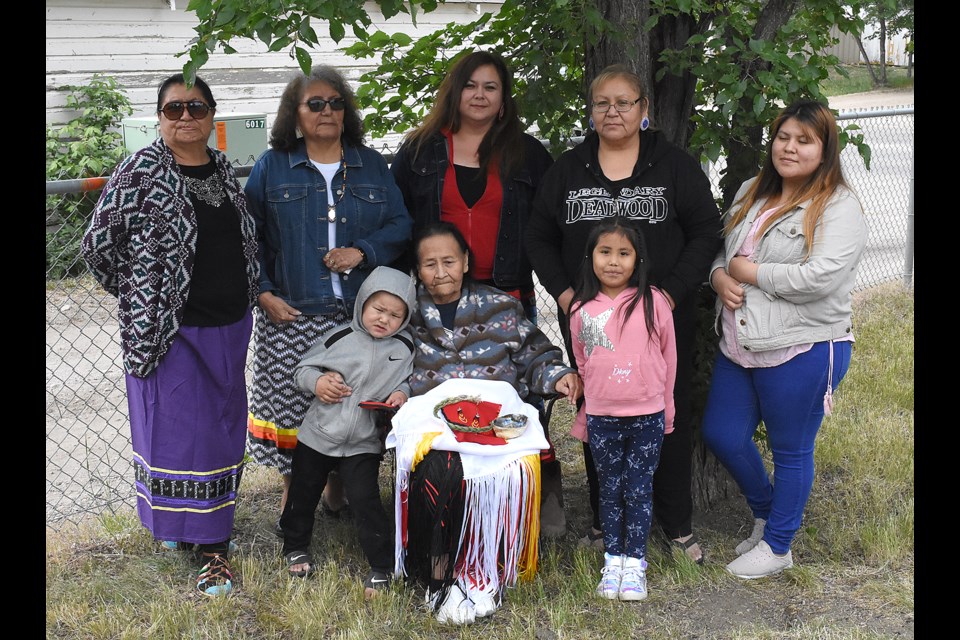But this one had a history – and a connection that went all the way back to the Battle of Little Bighorn, or Custer’s Last Stand.
The grave belongs to Tasinaskawin Brule, the wife of Chief Black Bull, one of the Lakota Sioux chiefs who played a large role in the famous battle and later moved his tribe into southern Saskatchewan, settling in the Moose Jaw and Wood Mountain areas.
Tasinaskawin passed away in 1910, and is the only First Nations person buried in the cemetary. There she laid, virtually forgotten until the early 2000s when Warren, Mich.-based historian Ron Papandrea started researching information for what would turn into his book ‘They Never Surrendered’, which chronicled Little Bighorn and the aftermath of the tribes that fought – including Black Bull’s Lakota.
It was through his work that Tasinaskawin’s grave was ‘discovered’, leading Papandrea to spearhead a restoration effort that was officially unveiled on Sunday afternoon at the cemetary.
Dignitaries from various local groups joined Papandrea and members of the Black Bull family, who travelled all the way from Rosebud, S.D. to take part in the ceremony.
“It’s really a great honour to be able to come up here and know where our relatives are laying,” said Sunrise Black Bull, one of those who made the journey. “My grandfather was born in 1900 and passed in 1999, I was 18 years old, so I got to hear almost a century worth of his stories. Then Ron pops into our lives and all the dots started to connect. And my grandmother (Lillian Black Bull-Straight), she’s a great granddaughter and the last of all her siblings, so we had to bring her out here.
“It’s really comforting that people actually care and wanted to take part in this.”
The unveiling included a sage smudge by Eldon Black Bull, aimed at removing any negative energies and thoughts and to clear the air in order to focus on Tasinaskawin. An offering of wasna – a variant of pemmican – was offered at the gravesite, prayers and speeches were made in the Lakota Sioux language. All with the goal of giving Tasinaskawin’s spirit something she would recognize.
“It’s just sharing a little piece of the traditions and history we have,” Black Bull said.
The group also presented Papandrea with a Lakota star quilt and local elder Elizabeth Michalski with a shawl.
The honour was especially touching for Papandrea, who has spent many an hour on researching the legacy of Black Bull and history of First Nations in the Moose Jaw area.
“I started off at the Custer Battlefield, I was interested in military history and I wanted to know what happened to the natives,” he said by way of explanation. “Five thousand came up to Canada, that was a lot of people at the time and they outnumbered everyone in the area. And they didn’t want to go back to the United States, so they settled around Wood Mountain, where their descendants are today.”
Black Bull and his tribe made their home in and around Moose Jaw and were even part of the Northwest Rebellion, providing mounted scouts for the Canadian Forces.
“So he was a Canadian patriot and he’s not recognized,” Papandrea said. “All people recognize is how he went to Batoche, which isn’t true, there are photos of him with the Halifax Battalion that was coming back and camped in Moose Jaw for six weeks… if he had fought against them, he would have been given the Riel treatment, they were hanging people, they were upset.”
Revising that misbelief has been a goal of Papandrea’s ever since, beginning with his book, continuing with the grave restoration and moving on into the future – while ideally seeing Moose Jaw do more to embrace their First Nations history.
“The Custer Battlefield has 400,000 people a year go to that battlefield, and the Indians that beat Custer moved in here at Moose Jaw and lived here for 30 years,” he said. “That’s the tourist story, that’s what they should be promoting… they could set up teepees and have actors playing the parts of the people who were involved. We know these characters and it’s really interesting.”
In order to further his cause, Papandrea plans to donate the star quilt to a local museum, ideally for exhibit in the future alongside other information on the Black Bull tribe.
“They really were lost and now they’re not,” he said. “It’s an important thing for them and it’s historic.”




